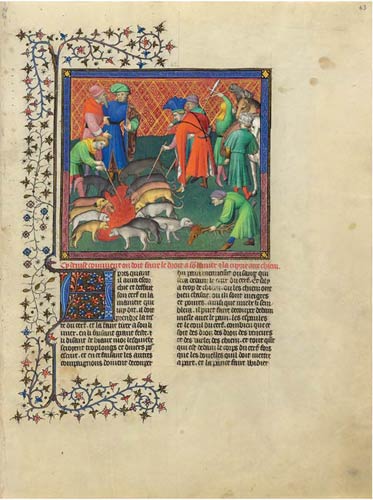
Two huntsmen wear the fashionable calf-length houpeland in this miniature. To the left, the man in the blue fur-lined houpeland also wears a capeline, or "bag hat" (as do the man he speaks with and the youth at the lower right). The "bag hat" would remain popular until around 1430. The other hunter wears an orange ermine-lined houpeland. His hat, with its crown of blue ostrich feathers, is the artist's invention. Behind him, two assistants wear their chaperons in imaginative ways. The cape of the yellow chaperon falls down the back of one helper, while the cape of the white chaperon worn by the other juts straight up, imitating a tall bonnet.
Luxury in a Time of Madness
In 1392 King Charles VI suffered the first of forty-four bouts of madness that would cripple his reign. During a lull in the Hundred Years' War, strife between France and Burgundy erupted into civil war. This domestic crisis was sparked by the 1407 assassination of Charles's brother by Duke John of Burgundy. In 1419 the duke, in turn, was murdered by supporters of the crown. During these tumultuous times, fashion reached unbelievable heights of luxury.
Men's and women's fashions were dominated by a new garment, the houpeland. Men's houpelands featured enormous sleeves and a skirt ranging from full length to crotch level. The pourpoint remained popular, albeit often finely embroidered and equipped with large sleeves. Accessories included fancy baldricks (sashes) and belts—both sometimes hung with bells. Tall bonnets or chaperons, often tied into imaginative shapes, completed the look.
Women's houpelands were always full length, with bombard or straight sleeves. The simpler cote hardy, with its voluminous skirt and tight upper body, continued to be worn. Women began to wear their hair in temples, a double-horned coif surmounted by veils or a tubular burlet.
